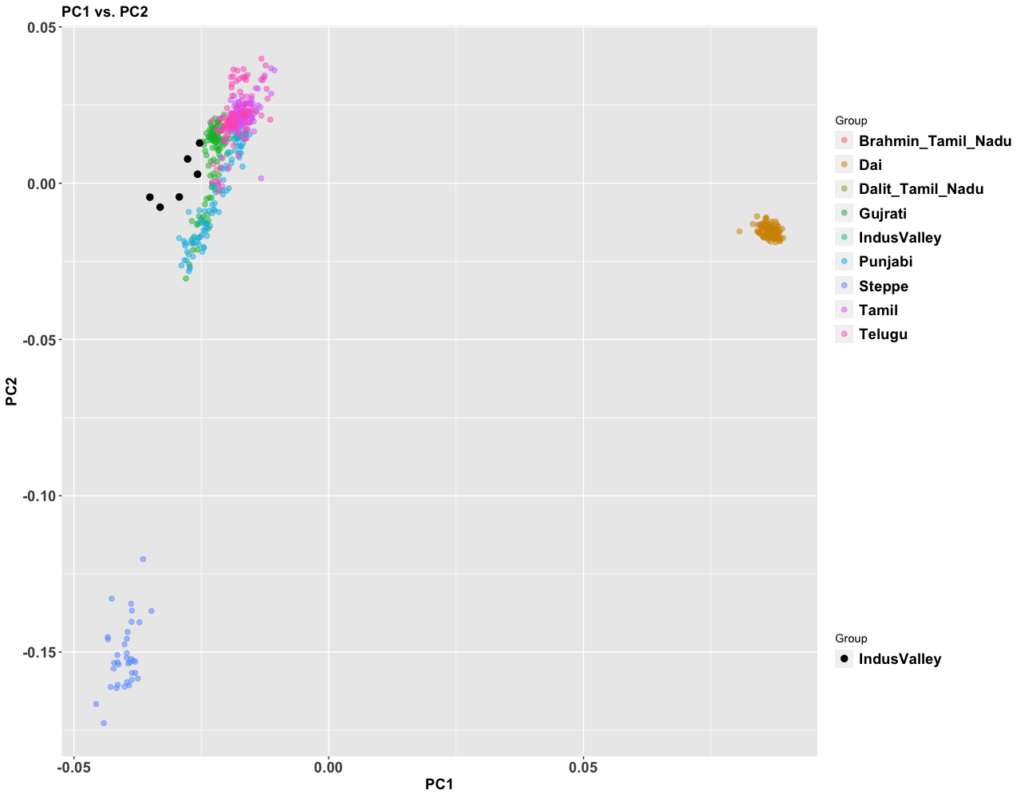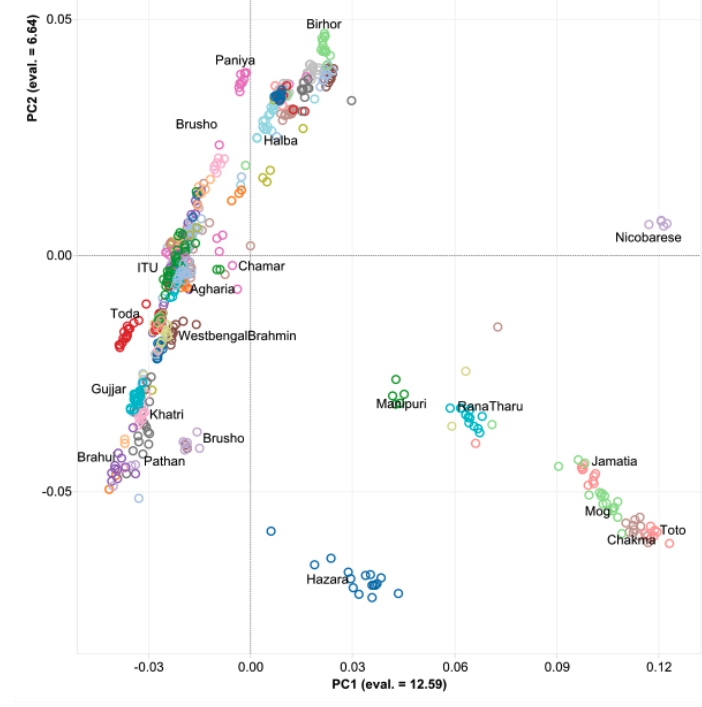I noticed something interesting a few weeks ago in the supplements of the Genomes Asian 1000K paper. Look at where the Toda are on the PCA.
Now look at the Indus Valley samples I have….

I don’t have access to the Toda samples. But there’s a lot of evidence that this is a very unique population that resembles the IVC population in having less AASI but not too much (if any) steppe.

Another most important class of early buildings, and one purely Buddhist, is that of the chaitiya-hall (Buddhist temples).
The prototype perhaps survives in the dairy temple of the Todas. We are well acquainted with the structural peculiarities of the chatiya-halls, from the many examples excavated in solid rock. These have barrel roofs, like the inverted hull of a ship, with every detail of the woodwork accurately copied in stone. The earliest date from the time of Asoka(3rd century B.c.) and are characterised by their single-arched entrance and plain facade.
from
Ananda Coomaraswamy: The Arts and Crafts of India and Ceylon (1913)
excerpts and photos here
https://sbarrkum.blogspot.com/2018/07/ananda-coomaraswamy-arts-and-crafts-of.html
I think Kodava people are probably the other group that is close to IVC
The Toda phenotype looks perfectly Latin American like in the Mestizo -Harnizo range. Makes sense considering their PCA position. Some west shifted Gujarati Vanias will also cluster with them.
Based on analogous mapping the NW South Asians like Arain and Kamboj would cluster west of Khatris, with west shifted Pathans, while Jatts and Rors, and UP Jaats would be even more West shifted and next to the Brahui on this PCA, but more Steppe shifted. This makes the PCA range in India absolutely massive, like 5X that of Europe.
Gujaratis are quite close to Eastern IVC individuals.
patidars
I’ve been thinking this for years.
And it’s no surprise; physical anthropologists have long noted that many Toda individuals resemble Balochis and Sikhs far more than they do characteristic individuals in other South Indian populations.
So it seems that outside the true and proper Indian cline ranging from UP Brahmins to the Irula, India is actually home to quite a few “relic” populations.
For one, we have the Jaats and Rors of Haryana; clearly an Aryan/Vedic population that has survived relatively unadmixed into the present. They have around 40% Steppe_Central_MLBA admixture, so they’re nearly hybrids of a sort between ancient Harappan North Indians and populations from the BA steppe. So, I wouldn’t be surprised if they’re approximately 80% Vedic Aryan.
In addition, we have a far lesser known population: the Arains of Uttar Pradesh. Most are familiar with Punjabi Arains, but the small community in UP is genetically distinct. They cluster near true eastern Pashtuns (not admixed ones… but real, unadmixed eastern Pashtuns from the tribal areas). They are even more anomalous than Haryana Jaats and Rors, at least in the broader context of South Asia, because their primary stream of ancestry is something close to the Bactria-Margiana Civilization of Central Asia! I have no clue whatsoever as to what’s going on with their history, and unlike Jaats there’s no real literature in English concerning them.
And finally, we have the Todas, who are the last surviving examples of West Eurasian-type Harappans.
India is an incredible place; endogamy and social isolation has allowed for the preservation of some very interesting and distinctive genetic profiles
Of course, the vast majority of Indians are still probably situated somewhere along the UP Brahmin-to-Irula Cline. But these unique, anomalous populations are still comparatively large, when compared with similar outlier populations in other regions.
Initially they’re thought to be genetically similar to other tribals from Western ghat despite their phenotype significantly more Western Eurasian shifted than their neighbors. Now after their genetic result, I think they’re the most Western Eurasian/Iran_N shifted South Indian group. ( Without any Steppe I guess ).
Indeed India seems to be a veritable mosaic of Central and South Asian ethnicities living side-by-side without mixing for centuries. This means that within South Asia, geography and genetics do not show a perfect correlation, resulting in many NW Indian populations clustering much further west than their physical location, genetically clustering with populations residing in Afganistan, Tajikistan and Southern Iran. (Parsis and Iranis are included in this pattern as they are more West shifted than Baloch despite harboring at least 11-15% AASI)
The Kamboj of India cluster with Swat and Kurram Pakhtuns, whereas the Arain of India cluster with Pakhtuns and Pashtuns with Dard affinities of North and East Afganistan and Northern Pakistan. Jatt Sikhs have a wide range but some cluster with Kho and Kamboj and others with Arains. Rors and Jaats cluster as west shifted as Kandahar Pashtuns but with far more Steppe (up to 47% Steppe among UP and Haryanvi Jaats) resulting in them clustering closer to Tajiks with high Steppe while Southern Pashtuns have an Iranian pull.
There are also Sindhi UC Dharmic populations living in India that cluster with certain Baloch tribes and Brahui tribes. No wonder the diversity of phenotype in India alone is so large, the genetic difference/range is mind boggling.
Shame we don’t have any genoplot or g25 samples would be neat to see their breakdown